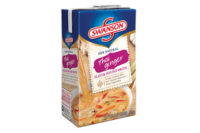Fruit and Nut Creative Enhancements

Only a couple of years ago, blood oranges were the buzz in the global culinary world. Restaurant chefs made all sorts of citrus-sweet and savory dishes using these oranges. And, beverage manufacturers used blood oranges to make a variety of mixed fruit juices. The peels of blood orange, as well as the widely grown Seville orange’s peels, have also been used to produce an assortment of marinades and candies.
Chicago-based, celebrity chef Charlie Trotter has a line of 4oz-portion packages of smoked salmon in retail stores. One of the flavors is the Citrus Cured Smoked Salmon, made with salmon, kosher salt, natural cane juice, orange peel, lemon peel, vodka, assorted herbs, spices and hardwood smoke.
In terms of savory flavor, lemons and limes are usually associated with fish and chicken products. However, Preferred Brands International launched a product called Thai Lime Rice. It is packaged in an 8.8oz, microwavable pouch and marketed under the company’s brand, Tasty Bite. The product has a combination of a zesty lime and cream coconut taste, made from white rice, coconut milk, sunflower oil, raw sugar, lemongrass, salt, lemon juice, natural flavoring (soy, vegetable), basil, lime, onions, garlic, green chilies, galangal and spices. Melons have been one of the less commonly used fruits in packaged foods, but they can add a key point of differentiation.
For generations, families in the Southern U.S. have enjoyed sweet-pickled watermelon rind, which is made from the white flesh of the watermelon, cut into bite-size squares, cooked and canned in vinegar and sugar. The texture is similar to the flesh of a sweet pickle. Since 1947, Old South has been producing its version of watermelon rind, sold in a 10oz jar. The ingredients are watermelon rind, corn syrup, sugar, water, salt, spices and sodium benzoate. Serving suggestions include using the rind cubes as a condiment for beef, pork, fish and poultry dishes, or cutting the cubes of rind in small dices and using them in tuna or seafood salads. Another suggestion—wrap bacon around the rind; bake them; and serve as appetizers.
A Nod to Nut Creativity and Nut Butters
For the past few years, chefs and manufacturers have paid close attention to allergy concerns, when they have used nuts in their daily operation. Due to allergy awareness, restaurant chefs must inform their customers if nuts are used in foods sold in their establishments. And, manufacturers must highlight on product labels if nuts are used as an ingredient, or if nuts are used in the facility where their products are being made.
Several nut manufacturers are finding alternative ways to promote products, by pushing the nutritional benefits of eating nuts. Kraft Foods launched a line of nutritious nuts, under its Planters brand, called NUT-rition. There are six products under this brand: Heart Health, Antioxidant, Digestive Health, Omega-3, Energy and Bone Health. The Heart Health Mix is one of the popular ones, made with peanuts, almonds, walnuts, hazelnuts, peanut and/or cottonseed oil, and sea salt. Planters’ intention is to promote the good fats, dietary fiber, vitamins and minerals with this line.
Most consumers are familiar with shea butter, when it comes to lotions, creams, hair shampoos and conditioners, because it has a good amount of vitamin A, E and antioxidant properties. A less conventional nut butter to watch is shea butter—which is also edible and can be used as an ingredient to prepare food. For years, chocolate manufacturers have used it as a substitute for cocoa butter. Shea butter is a fat, extracted from the nut of the shea tree–mostly grown in Africa. Shea nut oil also has GRAS status in the U.S.
Chefs continue to experiment with shea butter to make biscuits and cakes, as well as rice dishes. It gives the dishes a rich taste. There are many different grades of shea butter in the marketplace. However, it is recommended to use only grade A, unrefined quality for cooking purposes.
Kettle Foods is well-known for its large line of flavored potato chips–from the spicy Thai version to the sweet onion. Recently, the company launched a line of nut-based butters. Flavors include almond, cashew, hazelnut and organic peanut butter. These nut butters are marketed as condiments, to be used as spreads for breads and dippers for vegetables.
Stonewall Kitchen makes a peanut sauce, Roasted Garlic Peanut Sauce, to be used as a satay and dipping sauce. The ingredients are peanut butter, sugar, water, tomato paste, white vinegar, canola oil, roasted garlic, spices, red wine vinegar, canola oil, molasses, salt, mustard, onion, curry powder, sesame oil, xanthan gum, citric acid and garlic oil. Serving recommendations include skewered grilled chicken, shrimp or beef; or tossed/served over cooked noodles or grilled vegetables.
Nuts have even taken center stage in some entrees. The MooMoos Cuisine Company produces a 9oz, frozen vegetarian entrée called Roasted Cashew Stir-fry, made with whole-grain noodles, roasted cashews, scallions, cabbage, red bell peppers, basil, pineapple, sesame seeds and soy sauce. The entrée is claimed to be lactose-free and uses 100% natural ingredients. pf
For other articles on this topic or by chef Jones, type “Fruitful Bounty,” “almonds” or “Wilbert Jones” in the search field at PreparedFoods.com.
Looking for a reprint of this article?
From high-res PDFs to custom plaques, order your copy today!






